Growing Peppers Indoors – Guidelines & Tips
Growing peppers indoors can be a fun and rewarding hobby. With just a little bit of effort, you can create an indoor garden full of tasty peppers that can be used in all kinds of cooking. Here are some tips and guidelines to help you get started.
Choosing the Right Variety of Peppers
When it comes to growing peppers indoors, the variety of pepper you choose to grow is extremely important. It’s best to choose a variety that has been specifically bred for indoor growth, rather than one designed for outdoor growth. Examples of peppers suitable for indoor growth include the ‘Cubanelle’ and ‘Serrano’ varieties. By choosing the right variety of pepper, you will increase your chances of success significantly.
Selecting a Container
The container you choose to use for growing your peppers should be large enough to accommodate your pepper’s root system. It’s also important to make sure the container is at least 8 inches deep, as this will provide enough space for the roots to spread. When it comes to material, terracotta and plastic are both suitable. However, terracotta will provide better air circulation, helping to regulate air and soil temperature.
Positioning the Container
When it comes to positioning your container, ensure that it is placed in a location that will receive plenty of indirect sunlight. Peppers need at least 8 hours of sunlight per day, so it’s important to place it in a spot that is both sunny and away from any direct drafts. Additionally, the container should be placed atop a saucer or other raised surface, as this will help to minimize water damage to the floor or furnishings around the container.
Soil Preparation & Fertilization
When it comes to preparing your soil, it’s best to use a commercial potting mix that contains peat moss and perlite. Additionally, it’s important to make sure that the soil is well-draining, so it’s a good idea to mix in some horticultural sand for extra drainage. As for fertilization, nitrogen-rich fertilizers such as fish emulsion are recommended, as this will help promote healthy growth.
Watering & Pruning
When it comes to watering, peppers need to be watered regularly but it’s important to avoid overwatering. Check the soil for moisture level and only water when the top 1-2 inches of soil feel dry to the touch. As for pruning, it’s important to prune off any dead or diseased foliage, in addition to any peppers that have begun to mature. This will help to keep the plant healthy and ensure a more productive harvest.
Harvesting & Storage
When your peppers reach maturity, it’s important to harvest them as soon as possible. Once harvested, store the peppers in an air-tight container in the refrigerator. This will help to keep them fresh for as long as possible.
All in all, with just a little bit of effort, you can successfully grow peppers indoors. Just follow these guidelines and tips, and you’ll be able to enjoy a profitable and delicious harvest. Happy growing!



